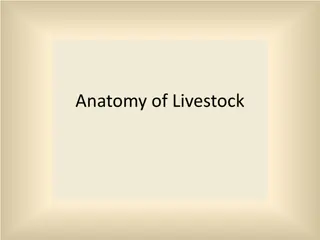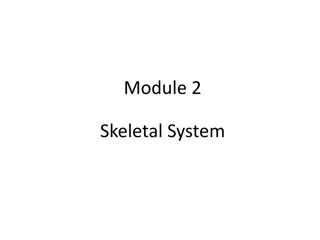Understanding Animal Skeletal System: Importance and Components
The skeletal system in animals plays a crucial role in providing structural support, facilitating movement, and offering protection to vital organs. It is composed of various components like bones, joints, ligaments, tendons, compact bone, and spongy bone. Different types of bones in an animal's body serve specific functions, such as support, protection, and facilitating locomotion. Understanding the skeletal system is essential to ensure the overall health and well-being of animals.
Download Presentation

Please find below an Image/Link to download the presentation.
The content on the website is provided AS IS for your information and personal use only. It may not be sold, licensed, or shared on other websites without obtaining consent from the author. Download presentation by click this link. If you encounter any issues during the download, it is possible that the publisher has removed the file from their server.
E N D
Presentation Transcript
11.0 Describe Animal Health Needs 11.3 B Skeletal System
What is the function of bone? Bone helps with: Movement Support Protection
Function Of Skeletal System Structural Support Movement Protection
What is bone made of? Bone is comprised of: 26% minerals (mostly calcium phosphate and calcium carbonate) 50% is water 4% is fat 20% is protein Bone requires adequate amounts of vitamins and minerals in the ration.
Important Terms Related to the Skeleton Skeletons can be divided into two sections, which include a. Axial Skeleton These bones are on or close to the midline axis of the body and include the skull, vertebrae and ribs. b. Appendicular skeleton These bones project from the body in the pectoral (front) and pelvic (hind) limbs, and are connected to the body through the bones of the girdles.
Other Skeletal Components Joints points where two or more bones meet. Ligament Tough band of connective tissue connecting one bone to another.
More Important Components Tendon Thick band of connective tissue that attaches muscle to bone. Found at the end of a muscle. Muscle contracts it pulls on the tendon; which pulls the bone for movement.
Compact Bone layer of protective hard bone tissue surrounding every bone Spongy Bone Soft bone filled with many holes and spaces surrounded by hard bone.
Types of bones in the animal body Long Bones--They serve as support columns. They assist the animal in body support, locomotion and eating. Example: Femur Short Bones--They are shaped like a cube and are located in complex joints, such as the knee and hock. They diffuse concussion and diminish friction. Example: Hock Flat Bones--They protect vital organs such as the brain, the heart, and the lungs. They are longer and wider than they are thick. Example: Scapula
Types of bones in the animal body Pneumatic bones--they contain air spaces called sinuses that are in contact with the atmosphere. Example: Frontal face bones. Irregular Bones--important to the protection and support of the central nervous system and are points of some muscle attachment. Example: Vertebrae Sesamoid Bones--they are flat and round. They are located along the course of tendons. Example: Kneecap or patella
Horses Skeleton Stay in Your Groups!























